It’s been a couple weeks since I posted here, so I feel as if I owe you something extra-special to make up for my absence. I’d like to tell you about a practice session that I had a week ago with the “usual suspects” — National Master Gjon Feinstein, class A player (soon to be expert) Thadeus Frei, and class B player (soon to be an A player) Cailen Melville.
Warning: This is a long post! I recommend getting a physical board before you read on, and maybe you might also want to print out the post to avoid getting lost in the variations. For those of you who are Chess Lecture subscribers, I’m also thinking about doing a lecture on this, so you could wait for that if you want.
Do you have your board ready? First, I want you to take a look at the following position. A good, long look. Allow yourself at least five minutes, and ask yourself two questions:
(A) What is the right move for Black?
(B) What is your assessment of the position?
Position 0. Black to move.
Okay, now for some back story. Cailen, John, Thadeus and I were analyzing one of my games in the US Open, but I use the word “analyze” loosely. On move 6 (!) Gjon suggested an improvement for me. We kept on going with Gjon’s suggestion until we reached this position on move 18 (!!). As I have said before, any analysis that goes more than 10 moves past an actual position that occurred in the game qualifies as “fantasy chess.” So we are definitely in fantasy-land here. But it is a very beautiful fantasy, as you will see.
“Hold it!” Gjon said, with insight born of many years of chess teaching. “Why don’t we try Dvoretsky’s exercise here? Let’s each take a piece of paper, analyze this position, and then write down our thoughts. After we’re done, we’ll compare notes. I think this will be a really good position to try Dvoretsky’s idea.”
[Note: Cailen has been reading a book by Russian GM Mark Dvoretsky, and he suggested this as exercise as a way to improve your analysis skills.]
So we analyzed in silence for a little while. Thadeus finished first, Cailen finished second, then Gjon, and finally I stopped — not so much because I was done analyzing, but because I was confident in what I would play.
Then we revealed our notes.
At this point I am going to change the story a little bit, and write our conversation not as it really occurred, but as a Socratic dialogue. I will, however, put each idea into the mouth of the person who really came up with the idea. This “scripted” version of our calculation will allow me to introduce a fifth participant who wasn’t really there: Rybka 3, super-super-grandmaster chess program extraordinaire, who has a couple of cogent points to make later on.
Position 1. White to move.
Thadeus. So of course I looked at 18. … Nxg2. White has to take (otherwise he has just lost a pawn for nothing). So 19. Kxg2 Qh3+. [See Position 1.] Now White has two options: 20. Kg1 or 20. Kh1. I thought the main line was 20. Kh1.
Dana. Isn’t that funny? I thought the main line was 20. Kg1. I think that puts up a tougher fight.
Gjon. I spent most of my time on 20. Kh1, like Thadeus. So let’s see what he has to say.
Thadeus. Now I figured 20. Kh1 Ng4 21. Bxg4 (forced, because there is no other way to defend both … Qxh2 mate and … Nxf2+, forking the king and queen) Bxg4 22. Qb3. [See Position 2.]
Rybka (standing in the background, unheard by any of us). *cough* Stupid human move. *cough*
Position 2. Black to move.
Thadeus. Now, of course, 22. … Re6 …
Dana. Wow! Are y0u serious? The only move that I looked at was 22. … Bf3+. I wonder if the change in the move order makes any difference?
Gjon. 22. … Bf3+ was the move that I looked at, too. Can we go over that first, before we look at Thadeus’ move? After 22. … Bf3+, 23. Nxf3 (of course) Qxf3+.
Cailen. Wait, what about 23. … ef?
Dana. Doesn’t work. If 23. … ef, White plays 24. Rg1 and 25. Rg3 next move. End of attack.
Gjon. Right. So Black has to play 23. … Qxf3+ 24. Kg1. Now Black plays the rook lift 24. … Re6, and here I was thinking about 25. Qd1. [See Position 3.]
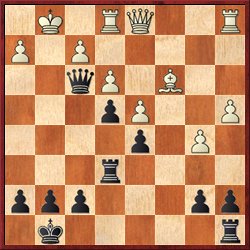
Position 3. Black to move.
Dana. I looked at this line, too. I wrote down 25. … Rg6+ 26. Kf1 Qh1+ with either a draw by repetition or maybe sufficient compensation for Black after 27. Ke2 Qxh2.
Gjon. That’s kind of what I thought, too, except I had 26. … Qh3+ 27. Ke2 Qh5+ 28. Kf1.
Dana, Cailen, Thadeus. But wait a minute, why not 27. Kd2?
Gjon [slaps his forehead]. Oh my god, d2 is free? I am so embarrassed. When I did my analysis I still thought the knight was on d2. Oh well. Never mind me …
Dana. Aha! I see a better way for Black to play here. Instead of 25. … Rg6+, which chases White’s king toward the center, why not 25. … Qh3!, which keeps him locked up in a mating net? Now the threat is 26. … Rg6+ followed by 27. … Qg2 mate. If 26. Kh1, which is White’s only defense, then 26. … Rh6 mates next move! So White is busted in position 3. [Note to reader: To be perfectly honest, I didn’t discover 25. … Qh3 until after I got back home. That’s why this Socratic dialogue is an improved version of reality.]
Gjon. Okay, so 25. Qd1 is out, so White has to play 25. Qxd5. Now the little trick with 25. … Qh3 won’t work any more, because after 26. Kh1 Rh6 White defends the h-pawn with 27. Qe5. So Black has nothing better than a draw by repetition with 26. … Qf3+ 27. Kg1 Qh3 etc.
Dana. And if 25. … Rg6+ 26. Kf1 Rg2 27. Re2 (nothing else works — if 27. Ra2 Rxh2 and White’s king stumbles over his rook on his way to the exits) 27. … Rxh2 28. Ke1 Rh1+ 29. Kd2, and I think that White is surviving! [See Position 4.]
Position 4. White’s King: Free at last! Praise the Lord, I’m free at last!
Dana. Okay, so it looks as Black has nothing better than a draw after 22. … Bf3+. Let’s look at Thadeus’s move [from Position 2], 22. … Re6.
Gjon. You know, I realize now that I did think a little bit about 22. … Re6, but the move that stopped me was 23. Qxd5, just like in the lines that we just analyzed. I think this is a real problem for Black. [See Position 5.]
Position 5. Black to move. Hint: Black to move AND WIN.
Dana. Jeez, I don’t see anything better for Black here than 23. … Bf3+ 24. Nxf3 Qxf3+, which transposes into the line that we just looked at.
Gjon. 23. … Rh6 doesn’t work, because of 24. Qe5.
Dana. 23. … Rae8 looks like a possibility, in order to defend the e5 square, but the problem is that White can just play 24. Qg5, heading for f4, or even better 24. Qd7, which paralyzes the rooks in place. Thadeus, what did you see for Black?
Thadeus. Actually, I didn’t go any farther than this in my analysis. I just thought Black had to be winning, with all those pieces attacking White’s king.
Rybka (stepping forward from backstage). Indeed, you are wise beyond your years, little grasshopper. But none of you have found Black’s brilliant, and only, winning move in Position 5. Do you want to look for it some more, or bow down to the computer’s superior wisdom?
Gjon. I want to look for it some more.
Thadeus, Cailen, Dana. We bow down to the computer’s superior wisdom.
Rybka. Very well, then. I shall enlighten you. In Position 5, Black’s winning move is 23. … Rf6!! Admire, pathetic humans, and weep.
Dana. Oh, my god. It’s like a combination of all of the best features of the lines that didn’t work before. The idea, of course, is to play 24. … Rxf2, with mate on g2 or h2. White’s queen can’t defend both squares at once!
Gjon. If White defends with 24. Rf1, then he takes the flight square away from his king, and so 24. … Bf3+ 25. Nxf3 Qxf3+ 26. Kg1 Rg6+ is mate.
Dana. If White 24. Rg1, in order to defend g2 with his rook and h2 with his queen, as in the previous lines, then he loses to 24. … Rxf2 25. Qe5 Bf3+ 26. Nxf3 Qxf3+ 27. Rg2 Qxg2 mate.
Gjon. Or if White plays 24. Qe5 first, then 24. … Bf3+! (note that 24. … Rxf2 now is not as good because of 25. Qg3!) 25. Nxf3 Qxf3+ 26. Kg1 and another point of … Rf6 is revealed: Black now has 26. … Qxf2+ 27. Kh1 Qf3+ forcing mate.
Cailen. Well, not really forcing mate, but after 28. Kg1 Rg6+ 29. Qg3 Rxg3+ White loses his queen, and the game is as good as won for White.
Thadeus. Also, if 24. Nxe4, to protect the f-pawn, then Black mates in two with 24. … Bf3+!
Gjon. And finally, here is the computer’s last little trick. If 24. Kg1, again with the idea of protecting f2, then Black crashes through with the sacrifice 24. … Rxf2! 25. Kxf2 Qxh2+ 26. Kf1 Bh3 mate.
Dana. What I love about this move 23. … Rf6!! is that you can only appreciate it after you have seen what is wrong about all the other move orders. Also, it is amazing that Black wins by playing two “quiet moves,” 22. … Re6! and 23. … Rf6!!, in a row. And it shows that Thadeus’s intuition was correct. Just on principle, Black should not commit himself to 22. … Bf3+ because he wants to keep more pieces alive for the attack.
Rybka. Rationalize all you want, human, but you will never achieve my level of mastery.
Dana. Okay, well, we’re halfway through now. Black is winning after 20. Kh1. What about the other line, 20. Kg1? [See Position 6.]
Position 6. Black to move.
Cailen. I didn’t think this was very good for White. Black plays 20. … Ng4 and after 21. Bxg4 Bxg4 22. f3 (otherwise it will be mate in two after 22. Q moves Bf3) 22. … ef! and White has to give up a whole rook to stop checkmate.
Dana. That’s right, Cailen, except that in this line (unlike the last one) White doesn’t have to take on g4. A much better defense is 21. Nf1! [See Position 7.]
Position 7. Black to move. Hint: Black to move AND WIN.
Dana. Now did any of you see the move 21. … Nxh2!?
Cailen. Obviously not, because I didn’t look at 21. Nf1.
Gjon. Wow! Another piece sacrifice! But does it work? Let me see this. White has to take, of course: 22. Nxh2. (Otherwise, … Nf3+ would be curtains.) Then what?
Dana. Then I play 22. … Re6 [see Position 8], and he plays 23. Bg4 …
Position 8. White to move.
Gjon. Wait, I don’t doubt you, but first can we look at 23. Bf1?
Dana. Oh. Oops, I didn’t think about that. Then I would play 23. … Rg6+ 24. Kh1 Qh4! With the simple threat of … Rh6 and mate.
Gjon. And if I play 25. f4?
Dana. Then I play 25. … Qf2. You can’t defend both the mate on g1 and the mate on g2.
Gjon. [Long pause] I guess you’re right.
Dana. Just lucky, because I didn’t see any of that when I was analyzing.
Gjon. Okay, so let’s go back to the line that you looked at. White plays 23. Bg4 …
Rybka. *cough* Stupid human move. *cough*
Dana. And now 23. … Rg6, and if 24. f3 (the only move to save the bishop) 24. … ef 25. Qxf3 [see Position 9].
Position 9. Black to move. Hint: Black to move AND WIN.
Dana. And here I was thinking Black would play 25. … Bxg4, but suddenly I’m not so sure. After 26. Qxh3 Bxh3+ 27. Kh1 Bg2+ 28. Kg1 I’m not sure that Black has anything better than 28. … Bh3+ with a draw by repetition.
Gjon. No! There’s a better move in Position 9. Black should play 25. … Rxg4+!
Dana. Of course! What a shot! White can’t take the rook with the knight because his queen falls. Why didn’t I see that? And if 26. Kh1, now 26. … Rg3 27. Qf1 and … hmmm… I’m sure that Black is winning somehow. I mean, if nothing else there is 27. … Rxe3 and Black has three pawns for a piece.
Rybka. Allow me to put the finishing touch on the combination that you humans have stumbled into in such a comical fashion. The correct move after 26. … Rg3 27. Qf1 is 27. … Bf5!! The point is that after 28. Qxh3 Black does not recapture the queen, instead he plays 28. … Be4+! 29. Qg2 Rxg2. [See Position 10.]
Position 10. White to move. “The Mill”
Dana. I bow down before your superior wisdom, Rybka. This is too lovely for words. After two piece sacrifices, an exchange sacrifice (sort of) and a queen sacrifice (sort of), what could be better than ending up in the famous position known as “The Mill”? Black threatens both 30. … Rg6+, which forces White to give up his knight in order to stop mate, and 30. … Rc2+, which wins the loose bishop on c3. Either way, Black wins a full piece and ends up two pawns ahead.
Gjon. This truly was a position worthy of a deep analysis! So our conclusion is that the sacrifice 18. … Nxg2 is sound and winning for Black in all lines.
Rybka. In essence your conclusions are right, pathetic humans, but you have not found the best defense for White in either line. First, just before Position 2, White could have played 22. Qb1 instead of 22. Qb3. The point is to keep the queen on the first rank, which makes the following defense possible: 22. … Re6 23. Rg1 Rh6 24. Rg2 Bf3 25. Qg1!, giving up the exchange but ending all the mate threats. I calculate a 0.33-pawn advantage for Black here.
Dana. I see what you mean. No human would ever consider such an abject defense.
Rybka. But computers have no pride, and will play the most groveling move if it is the best.
Dana. And what is the other improvement?
Rybka. In position 8, you only considered 23. Bf1 and 23. Bg4. As usual, you humans are too proud, and you think that White should try to make threats. Instead, White’s best defense is 23. Bh5!, which threatens nothing but slows down the Black attack by one tempo. First, it prevents 23. … Rg6. Second, after 23. … Rh6 Black has to waste time chopping through the underbrush, and White can use this time to hang on with 24. f4! Rxh5 25. Ra2! Here I calculate a 0.66-pawn advantage for Black.
Gjon. Yes, I would be amazed if a human ever played a move like 23. Bh5. If we leave out “computer moves,” Black is definitely winning, and even if we allow “computer moves,” Black is better. I think we have finally gotten to the bottom of Position 0.
Dana. Now, can we go back to the game?
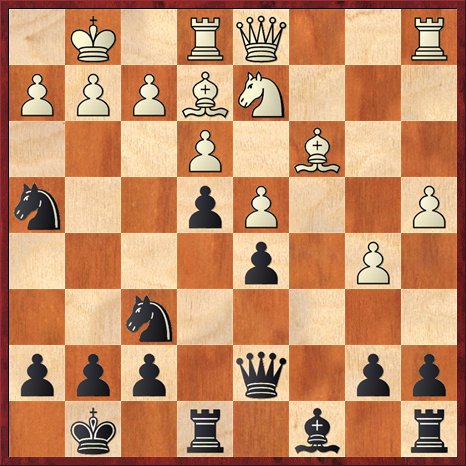
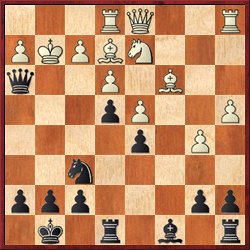
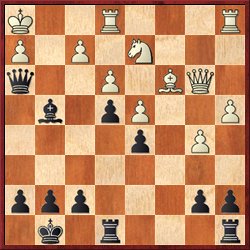
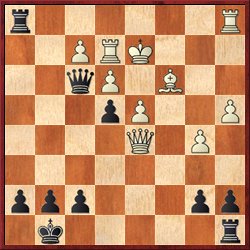
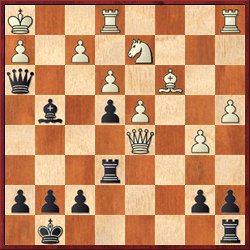
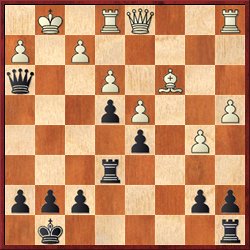
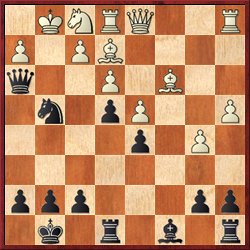
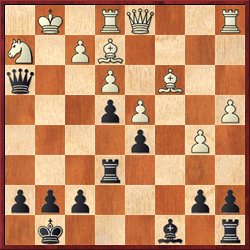

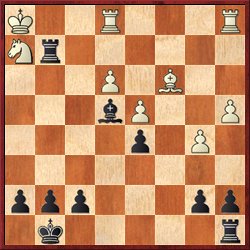



{ 1 comment… read it below or add one }
A long time ago I asked you if most expert players would see a position and independently assess the position the same and come up with the same steps on how to proceed.. You replied that it would depend on the individual. This was an excellent example on assessments. Looking forward to the chesslecture
{ 1 trackback }